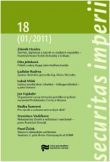Organizační vývoj německé pořádkové policie na území Protektorátu Čechy a Morava od ukončení vojenské správy po reorganizaci na podzim 1939
The organisational development of the German regular police force on the territory of the Protectorate of Bohemia and Moravia, from the end of the military administration through to the reorganisation in the autumn of 1939
Author(s): Jan VajskebrSubject(s): Government/Political systems, Security and defense, Interwar Period (1920 - 1939), WW II and following years (1940 - 1949), Fascism, Nazism and WW II
Published by: Ústav pro studium totalitních režimů
Keywords: Protectorate Bohemia and Moravia;German regular police;organistion
Summary/Abstract: The basic structure of the German regular police force was established on the territory of the Protectorate of Bohemia and Moravia in the course of the first six months of the occupation. The person entrusted with creating this structure was Jürgen von Kamptz, who was appointed as commander of the police of the Reichsprotektorat in May 1939. Police operational groups, which had operated on the territory during the military administration and for several weeks after its termination, were restructured at the beginning of June 1939 into two regiments, one for Bohemia and one for Moravia. During the deployment of police units in the Protectorate, the practice of having the greatest concentration of divisions was observed. As opposed to Germany, individual companies were not deployed in a dispersed manner, but an entire battalion (with just a few exceptions) was always concentrated in one place. In this way, the occupying government maintained maximum striking power in the event of major unrest. This concept could only be implemented thanks to the reactivation and rearmament of Czech, or rather Protectorate, police and the so-called government force, which took on a number of police duties. At the turn of July and August 1939, officers as well as rank and file police were also replaced by men from police divisions in Germany. The construction of the organisational structure of the Ordnungspolizei in the Protectorate, however, was severely disrupted by German aggression towards Poland, which many police units from the Protectorate were also involved in. The territory of Moravia and its police came under a military administration and another portion of the divisions were used to guard railway links. Even after the entire territory of the Protectorate once again came under the control of the office of the Reichsprotektorat, the regular police in the territory were reduced by a third. The police command therefore had to accede to the “wartime” redeployment of divisions, which again emphasised covering crucial garrisons. As early as October 1939, however, another reorganisation occurred, which gave a definitive form to the structure of the regular police in the Protectorate. Regiments and battalions were renamed and their composition was changed so that they roughly mirrored the set-up that existed in the summer of 1939. The method of supplementing new police units reflected wartime realities, i.e. it switched from a fully professional police corps to a mass organisation with a high proportion of reservists. The creation of new police units resulted in the massive reinforcement of the regular police, but at the same time it substantially reduced their standards in terms of qualified personnel and the quality of their equipment. Shortly after their reorganisation, the German uniformed police got an opportunity to show their readiness for action. They played one of the key roles in mass demonstrations and their subsequent repression in October and November 1939. In general terms, it is possible to state that the concept chosen for uniformed police units in the Protectorate was successful. It was maintained until 1944, when Ordnungspolizei units were substantially reinforced and restructured in connection with the expansion of the partisan war, which prefigured the end of the Nazi domination of the Czech lands.
Journal: Securitas imperii
- Issue Year: 2011
- Issue No: 18
- Page Range: 168-198
- Page Count: 31
- Language: Czech

